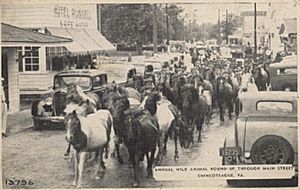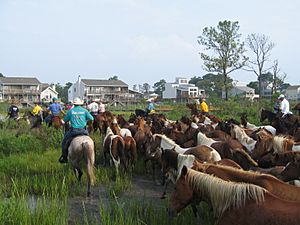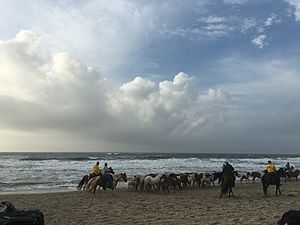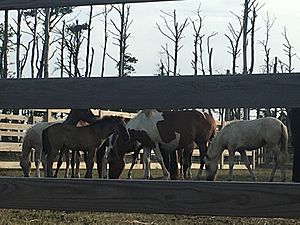Pony Penning facts for kids
Quick facts for kids Pony Penning |
|
|---|---|
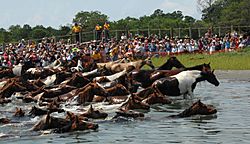
Chincoteague ponies arriving on Chincoteague after swimming the channel
|
|
| Status | active |
| Genre | auctions, carnivals |
| Frequency | Annually, on the last consecutive Wednesday and Thursday in July |
| Location(s) | Chincoteague Island, Virginia |
| Country | United States |
| Years active | 101 |
| Established | July 1924 |
| Attendance | 40,000-50,000 |
| Organised by | Chincoteague Volunteer Fire Department |
| Sponsor | Chincoteague Chamber of Commerce |
The Pony Penning is an exciting yearly event held in Chincoteague, Virginia. It's also known as Pony Penning Days or Pony Swim. This special event happens every year on the last Wednesday and Thursday in July. The main parts of the event are a pony swim on Wednesday and a pony auction on Thursday. But the fun actually starts on the Saturday before and ends on the Friday after.
During the pony swim, a group of people called the Saltwater Cowboys gather wild Chincoteague ponies. These ponies live on the Virginia side of Assateague Island. The cowboys guide them across the Assateague Channel to Veteran's Memorial Park on Chincoteague Island. The ponies swim when the water is calm, usually between 7:00 AM and 1:00 PM. Once on Chincoteague Island, the Saltwater Cowboys lead the ponies to pens at the Chincoteague Carnival Grounds. Here, all the young ponies (foals) are sold at an auction on Thursday. A few foals are chosen to be "Buybacks" and will return to Assateague Island later.
Contents
The History of the Chincoteague Ponies
No one is completely sure how the Chincoteague ponies first arrived on Assateague Island. One idea from the National Park Service is that horses were brought to the island in the 1600s. However, the Chincoteague Volunteer Fire Department, which owns the ponies on the Virginia side, has another theory. They believe the ponies are descendants of Spanish horses. These horses might have swum to the island from a Spanish ship that sank off the Virginia coast in the 1500s.
After the ponies arrived, people started the Pony Penning event. It was a way for locals to claim, brand, and train the wild horses.
Pony Penning: How It Started
By the 1700s, Pony Penning was already a yearly tradition. People would brand or mark unclaimed animals to show who owned them. The first time someone wrote about the Pony Penning was in 1835. By 1885, it had become a big festival. The event used to involve rounding up both horses and sheep on Assateague and Chincoteague Islands. Over time, there were fewer sheep and more ponies. So, the sheep penning stopped.
In 1909, the last Wednesday and Thursday of July were chosen as the official Pony Penning days. The event used to happen on both islands. But then a rich farmer bought a large part of Assateague Island. This made many settlers move to Chincoteague Island. Because of this, the Pony Penning had to change. By 1923, almost all parts of the event, except the actual roundup, moved to Chincoteague Island. For the first two years after this change, the ponies were moved by truck. The famous annual swim began in 1925.
Pony Penning Today: 1924 to Now
In 1922, a road called a causeway was built. It connected Chincoteague Island to the mainland of Virginia. The Chincoteague Volunteer Fire Company also started that same year. They formed after two big fires damaged the island. In 1924, the first official Pony Penning Day was held. Young ponies were sold for $25–50 each. The money raised helped buy fire equipment.
The fire department owns the pony herd. They have a special permit from the U.S. Fish and Wildlife Service. This permit allows the horses to graze on the Virginia side of Assateague Island. The fire department can keep up to 150 horses. In 1927, about 25,000 people came to watch the event. The Pony Penning became even more famous after the book Misty of Chincoteague was published in 1947 by Marguerite Henry. Now, between 40,000 and 50,000 people usually come to watch.
Since 1924, Pony Penning Day has happened every year. The only exceptions were 1942, 1943, 2020, and 2021. It was canceled in 1942 and 1943 because of World War II. In 2020 and 2021, it was canceled due to the COVID-19 pandemic. During the pandemic, the ponies were still rounded up. But they stayed on Assateague Island instead of swimming to Chincoteague. The young ponies were sold in an online auction instead of the usual live auction.
Meet the Saltwater Cowboys
The "Saltwater Cowboys" are members of the Chincoteague Volunteer Fire Department. They are in charge of the yearly pony swim. In the early days, there weren't enough riders on Chincoteague Island to help. So, Saltwater Cowboys were brought in from the mainland. There are about 40-55 Saltwater Cowboys today. Many of them have been in this role for most of their lives. Being a Saltwater Cowboy is a great honor. As of 2019, some cowboys were even third-generation members of their families. The oldest Saltwater Cowboy in 2019 was Jack Brittingham, who was 86 years old.
The Saltwater Cowboys take care of the wild ponies all year long. They round up the ponies three times a year. This is to give them vaccinations and health check-ups. Sometimes, they do extra round-ups if a horse or foal needs medical help. Some of the money from the yearly pony auction helps pay for the ponies' care. During spring roundups, the Saltwater Cowboys also release the "buyback" ponies from the previous year's auctions.
Getting Ready for the Swim: Roundup and Beach Walk
Before the big swim, the Saltwater Cowboys gather the ponies from the north and south parts of Assateague Island. They put them into corrals (pens). On the Monday before the swim, the ponies from the northern herd leave their corral at sunrise. They walk about five miles along the Atlantic Ocean shore. They join the ponies from the south herd at the southern corral. This event is called the Beach Walk.
On the Tuesday before the swim, the ponies are checked by vets. Pregnant mares and those with very young foals are taken out of the herd. They are moved between the islands in trailers. Ponies that are not healthy enough to swim are also trailered. During this time, the Saltwater Cowboys also choose which foals will be "buyback" ponies. These ponies are auctioned off but then returned to the island to help keep the herd strong.
The Exciting Pony Swim
The pony swim happens on Wednesday. It usually takes place between 7 a.m. and 1 p.m., depending on when the water is calmest. The exact time is announced the day before. The swim itself is very quick, lasting only about three to five minutes. Around 40,000 people gather on the shores to watch the swim. They watch from Veterans Memorial Park or Pony Swim Lane. There's often a big television screen at Veterans Memorial Park. This helps people in the back of the crowd see the swim.
The Saltwater Cowboys go into the channel with the ponies. Volunteers in boats, called "scowboys," help any ponies that might be struggling. This is especially true for the young foals. The first foal to reach the shore is given a special name: King or Queen Neptune. This foal is later raffled off to someone who bought a winning "Neptune Ticket" at the Chincoteague Carnival Grounds.
Sometimes, mother ponies (mares) can get a condition called hypocalcemia during the swim. Vets are on site to treat them right away. After the swim, the ponies rest for a short time. Vets check them again. Then, the Saltwater Cowboys lead them along Ridge Road in a parade to the Volunteer Fire Department Fairgrounds. Many people line the road to watch and help keep the ponies on track. At the fairgrounds, the ponies are put into corrals. Vets and people who might want to buy a pony check them again. All the young foals are separated from their mothers early the next morning. They will be auctioned off the following day.
Most of the ponies, including mothers with young foals, go back to Assateague Island on Friday. The northern herd is trailered back by the Saltwater Cowboys. The southern herd swims back across the channel by noon, guided by the cowboys.
The Volunteer Fireman's Carnival
The Volunteer Fireman's Carnival starts before the pony swim. It continues after the swim and into early August. After the swim, the Saltwater Cowboys lead the ponies to the carnival grounds. There, the ponies are kept in corrals. People can observe them, including the Saltwater Cowboys and anyone interested in bidding on a pony.
The Foal Auction
The yearly auction is a fundraiser for the Chincoteague Volunteer Fire Department. It also helps control the size of the pony herd. The fire department's permit allows them to have up to 150 horses. About 70 to 100 foals are born each year. So, the auction helps keep the numbers within the limit. The auction is led by auctioneer Tim Jennings.
On the Thursday after the swim, all the foals are auctioned off at the Volunteer Fire Department fairgrounds. As of 2019, more than 1,297 ponies have been sold at auction. Other items like photos are also auctioned. Usually, the money from one special foal is given to a local charity. Anyone can join the auction; you don't need to sign up beforehand. How you plan to take your new foal home must be approved by the pony committee. Ponies are usually picked up by 5 p.m. on the Friday after the auction. However, foals born after May 30th must be picked up in the fall.
The Feather Fund is a charity that helps children buy ponies at the auction. It started in 2003 to honor Carollynn Suplee. She used to help children buy ponies until she passed away from cancer. The charity believes that raising a foal teaches children important life lessons.
In 2020 and 2021, the auction was held online because of the COVID-19 pandemic. It was on SportHorseAuctions.com, owned by Tim Jennings. Pictures of the foals and information about them were posted online. Normally, the auction lasts one day, but the 2020 online auction lasted a whole week.
Buyback Ponies: Keeping the Herd Strong
Each year, some ponies are bought as "buyback" ponies. This means the person bidding donates money to the fire department. But they allow the pony to be released back onto Assateague Island. This helps keep the pony population healthy. The donors who buy back a pony get to name it. Buyback ponies usually get the highest bids. In 2023, a buyback mare named "SCC Misty's Hailstorm" set a record, selling for $43,000.
Auction Records: How Prices Have Changed
The average price paid for a pony has gone up over the years. Between 2016 and 2017, the average winning bids increased by 30 percent. In 2018, the average winning bid went up by 24 percent from the year before. The highest bid ever for one pony was $43,000 in 2023.
The 2020 online auction, held during the pandemic, brought in $388,000 in total sales. This broke the previous record by over $100,000. Records for the highest bid and average cost per pony were also broken that year. The highest bid is usually for a buyback pony.
Images for kids
See also
- Chincoteague National Wildlife Refuge
- Misty (1961 film)


